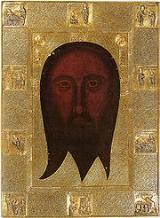
Veil of Veronica
Encyclopedia

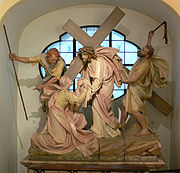
Crucifix
A crucifix is an independent image of Jesus on the cross with a representation of Jesus' body, referred to in English as the corpus , as distinct from a cross with no body....
Volto Santo of Lucca) is a Catholic
Catholic
The word catholic comes from the Greek phrase , meaning "on the whole," "according to the whole" or "in general", and is a combination of the Greek words meaning "about" and meaning "whole"...
relic
Relic
In religion, a relic is a part of the body of a saint or a venerated person, or else another type of ancient religious object, carefully preserved for purposes of veneration or as a tangible memorial...
, which, according to legend, bears the likeness of the Face of Jesus not made by human hand (i.e. an Acheiropoieton
Acheiropoieta
Acheiropoieta — also called Icons Made Without Hands — are a particular kind of icon which are alleged to have come into existence miraculously, not created by a human painter. Invariably these are images of Jesus or the Virgin Mary...
).
The most recent version of the legend recounts that Saint Veronica
Saint Veronica
Saint Veronica or Berenice, according to the "Acta Sanctorum" published by the Bollandists , was a pious woman of Jerusalem who, moved with pity as Jesus carried his cross to Golgotha, gave him her veil that he might wipe his forehead...
from Jerusalem encountered Jesus
Jesus
Jesus of Nazareth , commonly referred to as Jesus Christ or simply as Jesus or Christ, is the central figure of Christianity...
along the Via Dolorosa
Via Dolorosa
The Via Dolorosa is a street, in two parts, within the Old City of Jerusalem, held to be the path that Jesus walked, carrying his cross, on the way to his crucifixion. The current route has been established since the 18th century, replacing various earlier versions...
on the way to Calvary
Calvary
Calvary or Golgotha was the site, outside of ancient Jerusalem’s early first century walls, at which the crucifixion of Jesus is said to have occurred. Calvary and Golgotha are the English names for the site used in Western Christianity...
. When she paused to wipe the sweat (Latin suda) off his face with her veil, his image was imprinted on the cloth. The event is commemorated by the Sixth Station of the Stations of the Cross
Stations of the Cross
Stations of the Cross refers to the depiction of the final hours of Jesus, and the devotion commemorating the Passion. The tradition as chapel devotion began with St...
. According to some versions, Veronica later traveled to Rome to present the cloth to the Roman Emperor Tiberius
Tiberius
Tiberius , was Roman Emperor from 14 AD to 37 AD. Tiberius was by birth a Claudian, son of Tiberius Claudius Nero and Livia Drusilla. His mother divorced Nero and married Augustus in 39 BC, making him a step-son of Octavian...
and the veil possesses miraculous properties, being able to quench thirst, cure blindness, and sometimes even raise the dead.
The story is not recorded in its present form until the Middle Ages and for this reason, is unlikely to be historical. Rather, its origins are more likely to be found in the story of the image of Jesus associated with the Eastern Church known as the Mandylion, coupled with the desire of the faithful be able to see the face of their Redeemer. During the fourteenth century it became a central icon in the Western Church – in the words of art historian Neil Macgregor
Neil MacGregor
Robert Neil MacGregor, OM, FSA is an art historian and museum director. He was the Editor of the Burlington Magazine from 1981 to 1987, the Director of the National Gallery, London, from 1987 to 2002, and was appointed Director of the British Museum in 2002...
– “From [the 14th Century] on, wherever the Roman Church went, the Veronica would go with it.”
The story

Apocrypha
The term apocrypha is used with various meanings, including "hidden", "esoteric", "spurious", "of questionable authenticity", ancient Chinese "revealed texts and objects" and "Christian texts that are not canonical"....
l "Acts of Pilate
Acts of Pilate
The Acts of Pilate , also called the Gospel of Pilate, is a book of New Testament apocrypha. The dates of its accreted sections are uncertain, but scholars agree in assigning the resulting work to the middle of the fourth century...
". The story was later elaborated in the 11th century by adding that Christ gave her a portrait of himself on a cloth, with which she later cured Tiberius. The linking of this with the bearing of the cross in the Passion, and the miraculous appearance of the image was made by Roger d'Argenteuil's Bible in French in the 13th century, and gained further popularity following the internationally popular work, Meditations on the life of Christ of about 1300 by a Pseudo-Bonaventura
Pseudo-Bonaventura
The Pseudo-Bonaventura, or Pseudo-Bonaventure is the name given to the authors of a number of medieval devotional works which were believed at the time to be the work of Saint Bonaventure: "It would almost seem as if 'Bonaventura' came to be regarded as a convenient label for a certain type of...
n author. It is also at this point that other depictions of the image change to include a crown of thorns, blood, and the expression of a man in pain, and the image became very common throughout Catholic Europe, forming part of the Arma Christi
Arma Christi
Arma Christi , or the Instruments of the Passion, are the objects associated with Jesus' Passion in Christian symbolism and art....
, and with the meeting of Jesus and Veronica becoming one of the Stations of the Cross
Stations of the Cross
Stations of the Cross refers to the depiction of the final hours of Jesus, and the devotion commemorating the Passion. The tradition as chapel devotion began with St...
.
On the Via Dolorosa
Via Dolorosa
The Via Dolorosa is a street, in two parts, within the Old City of Jerusalem, held to be the path that Jesus walked, carrying his cross, on the way to his crucifixion. The current route has been established since the 18th century, replacing various earlier versions...
in Jerusalem there is a small chapel, known as the Chapel of the Holy Face.
Traditionally, this is regarded as the home of St Veronica and site of the miracle.
According to the Catholic Encyclopedia
Catholic Encyclopedia
The Catholic Encyclopedia, also referred to as the Old Catholic Encyclopedia and the Original Catholic Encyclopedia, is an English-language encyclopedia published in the United States. The first volume appeared in March 1907 and the last three volumes appeared in 1912, followed by a master index...
, the name "Veronica" is a colloquial portmanteau of the Latin
Latin
Latin is an Italic language originally spoken in Latium and Ancient Rome. It, along with most European languages, is a descendant of the ancient Proto-Indo-European language. Although it is considered a dead language, a number of scholars and members of the Christian clergy speak it fluently, and...
word Vera, meaning truth, and Greek
Greek language
Greek is an independent branch of the Indo-European family of languages. Native to the southern Balkans, it has the longest documented history of any Indo-European language, spanning 34 centuries of written records. Its writing system has been the Greek alphabet for the majority of its history;...
Icon meaning "image"; the Veil of Veronica was therefore largely regarded in medieval times as "the true image", and the truthful representation of Jesus, preceding the Shroud of Turin
Shroud of Turin
The Shroud of Turin or Turin Shroud is a linen cloth bearing the image of a man who appears to have suffered physical trauma in a manner consistent with crucifixion. It is kept in the royal chapel of the Cathedral of Saint John the Baptist in Turin, northern Italy. The image on the shroud is...
.
History of the Veronica
While the story has no basis in written history prior to the Middle Ages, there is no doubt that there was a physical image displayed in Rome in the thirteenth, fourteenth and fifteenth centuries which was known and venerated as the Veil of Veronica. The history of that image is however, somewhat problematic.It has often been assumed that the Veronica was present in the old St Peter's in the papacy of John VII
Pope John VII
Pope John VII was pope from 705 to 707. The successor of John VI, he was of Greek ancestry. He is one of the popes of the Byzantine captivity.-Biography:...
(705-8) as a chapel known as the Veronica chapel was built during his reign, and this seems to have been the assumption of later writers. This is far from certain however as mosaics which decorated that chapel do not refer to the Veronica story in any way. Furthermore, contemporaneous writers make no reference to the Veronica in this period. It would appear however that the Veronica was in place by 1011 when a scribe was identified as keeper of the cloth.
However, firm recording of the Veronica only begins in 1199 when two pilgrims named Gerald de Barri (Giraldus Cambrensis
Giraldus Cambrensis
Gerald of Wales , also known as Gerallt Gymro in Welsh or Giraldus Cambrensis in Latin, archdeacon of Brecon, was a medieval clergyman and chronicler of his times...
) and Gervase of Tilbury
Gervase of Tilbury
Gervase of Tilbury or Gervasius Tilberiensis was a 13th century canon lawyer, statesman and writer, apparently born in either East Tilbury or West Tilbury, in Essex, England.-Life and works:...
made two accounts at different times of a visit to Rome which made direct reference to the existence of the Veronica. Shortly after that, in 1207, the cloth became more prominent when it was publicly paraded and displayed by Pope Innocent III
Pope Innocent III
Pope Innocent III was Pope from 8 January 1198 until his death. His birth name was Lotario dei Conti di Segni, sometimes anglicised to Lothar of Segni....
, who also granted indulgences to anyone praying before it. This parade, between St Peter's and The Santo Spirito Hospital, became an annual event and on one such occasion in 1300 Pope Boniface VIII
Pope Boniface VIII
Pope Boniface VIII , born Benedetto Gaetani, was Pope of the Catholic Church from 1294 to 1303. Today, Boniface VIII is probably best remembered for his feuds with Dante, who placed him in the Eighth circle of Hell in his Divina Commedia, among the Simonists.- Biography :Gaetani was born in 1235 in...
, who had it translated to St. Peter's in 1297, was inspired to proclaim the first Jubilee
Jubilee (Christian)
The concept of the Jubilee is a special year of remission of sins and universal pardon. In the Biblical Book of Leviticus, a Jubilee year is mentioned to occur every fifty years, in which slaves and prisoners would be freed, debts would be forgiven and the mercies of God would be particularly...
in 1300. During this Jubilee the Veronica was publicly displayed and became one of the "Mirabilia Urbis" ("wonders of the City") for the pilgrim
Pilgrim
A pilgrim is a traveler who is on a journey to a holy place. Typically, this is a physical journeying to some place of special significance to the adherent of a particular religious belief system...
s who visited Rome. For the next two hundred years the Veronica, retained at Old St Peter's, was regarded as the most precious of all Christian relics; there Pedro Tafur
Pedro Tafur
Pedro Tafur was a Spanish traveler and writer. Born in Córdoba, to a branch of the noble house of Guzmán, Tafur traveled across three continents during the years 1436 to 1439. During the voyage, he participated in various battles, visited shrines, and rendered diplomatic services for Juan II of...
, a Spanish visitor in 1436, noted:
On the right hand is a pillar as high as a small tower, and in it is the holy Veronica. When it is to be exhibited an opening is made in the roof of the church and a wooden chest or cradle is let down, in which are two clerics, and when they have descended, the chest or cradle is drawn up, and they, with the greatest reverence, take out the Veronica and show it to the people, who make concourse there upon the appointed day. It happens often that the worshippers are in danger of their lives, so many are they and so great is the press.Pedro Tafur, Andanças e viajes.
After the Sack of Rome in 1527
Sack of Rome (1527)
The Sack of Rome on 6 May 1527 was a military event carried out by the mutinous troops of Charles V, Holy Roman Emperor in Rome, then part of the Papal States...
, some writers recorded that the veil had been destroyed: Messer Unbano to the Duchess of Urbino say that the Veronica was stolen and passed around the taverns of Rome. Other writers however, testify to its continuing presence in the Vatican and one witness to the sacking states that the Veronica was not found by the looters.
Many artists of the time created reproductions of the Veronica, again suggesting its survival, but in 1616, Pope Paul V
Pope Paul V
-Theology:Paul met with Galileo Galilei in 1616 after Cardinal Bellarmine had, on his orders, warned Galileo not to hold or defend the heliocentric ideas of Copernicus. Whether there was also an order not to teach those ideas in any way has been a matter for controversy...
prohibited the manufacture of further copies unless made by a canon of Saint Peter's Basilica. In 1629, Pope Urban VIII not only prohibited reproductions of the Veronica from being made, but also ordered the destruction of all existing copies. His edict declared that anyone who had access to a copy must bring it to the Vatican, under penalty of excommunication.
After that the Veronica disappears almost entirely from public view, and its subsequent history is unrecorded. As there is no conclusive evidence that it ever left St Peter's, the possibility exists that it remains there to this day; this would be consistent with such limited information as the Vatican has provided in recent centuries.
Images traditionally connected with the Veil of Veronica
There are at least six images in existence which bear a marked resemblance to each other and which are claimed to be the original Veil, a direct copy of it or, in two cases, the Mandylion. Each member of this group is enclosed in an elaborate outer frame with a gilded metal sheet (or rizaRiza
A riza or oklad , sometimes called a "revetment" in English, is a metal cover protecting an icon. It is usually made of gilt or silvered metal with repoussé work and is pierced to expose elements of the underlying painting. It is sometimes enameled, filigreed, or set with artificial,...
in Russian) within, in which is cut an aperture where the face appears; at the lower extreme of the face there are three points which correspond to the shape of the hair and beard.
St. Peter's Basilica
There is certainly an image kept in St Peter’s Basilica which purports to be the same Veronica as was revered in the Middle Ages. This image is stored in the chapel which lies behind the balcony in the south west pier which supports the dome.Very few inspections are recorded in modern times and there are no detailed photographs. The most detailed recorded inspection of the 20th century occurred in 1907 when Jesuit art historian Joseph Wilpert was allowed to remove two plates of glass to inspect the image. He commented that he saw only "a square piece of light coloured material, somewhat faded through age, which bear two faint rust-brown stains, connected one to the other".
Nevertheless, the face is still displayed each year on the occasion of the 5th Sunday of Lent, Passion Sunday
Passion Sunday
Passion Sunday is a name that the Roman Rite liturgy gives to the sixth Sunday of Lent, but that in the pre-1960 form of that liturgy was given to the fifth Sunday...
. The blessing takes place after the traditional Vespers
Vespers
Vespers is the evening prayer service in the Western Catholic, Eastern Catholic, and Eastern Orthodox, Anglican, and Lutheran liturgies of the canonical hours...
at 5.00 pm. There is a short procession
Procession
A procession is an organized body of people advancing in a formal or ceremonial manner.-Procession elements:...
within the basilica, accompanied by the Roman litany
Litany
A litany, in Christian worship and some forms of Jewish worship, is a form of prayer used in services and processions, and consisting of a number of petitions...
. A bell rings and three canons
Canon (priest)
A canon is a priest or minister who is a member of certain bodies of the Christian clergy subject to an ecclesiastical rule ....
carry the heavy frame out on the balcony above the statue of St. Veronica holding the veil. From this limited view no image is discernible and it is only possible to see the shape of the inner frame.
The Hofburg Palace, Vienna
This is an important copy of the Veronica, identified by the signature of P. Strozzi in the right hand corner of the inner frame. He was the secretary of Pope Paul VPope Paul V
-Theology:Paul met with Galileo Galilei in 1616 after Cardinal Bellarmine had, on his orders, warned Galileo not to hold or defend the heliocentric ideas of Copernicus. Whether there was also an order not to teach those ideas in any way has been a matter for controversy...
, and a man referred to by Vatican notary Jacopo Grimaldi as making a series of six meticulous copies of the veil in 1617.
The outside of the frame is relatively modern, while the inner frame is roughly made and corresponds to the cut-out pattern of earlier copies. The face within is very unclear, more a series of blotches in which only the bare elements of a nose, eyes and mouth can be identified. This argues for the authenticity of the copy as there is clearly no attempt at artistic enhancement. Furthermore, the fact of its being copied from the Vatican copy after the Sack of Rome in 1527 suggests that the original image may have survived that event.
It is kept in the Schatzkammer
Schatzkammer (Vienna)
The Imperial Treasury in Vienna, Austria is located in the Hofburg with its entrance at the Schweizerhof , the oldest part of the palace rebuilt in a Renaissance style under Emperor Ferdinand I...
of Sacred and Secular Treasurers of the Habsburg dynasty in the Hofburg Palace, Vienna.
Monastery of the Holy Face, Alicante, Spain
This relic was acquired by Pope Nicholas V from relatives of the Byzantine Emperor in 1453Fall of Constantinople
The Fall of Constantinople was the capture of the capital of the Byzantine Empire, which occurred after a siege by the Ottoman Empire, under the command of Ottoman Sultan Mehmed II, against the defending army commanded by Byzantine Emperor Constantine XI...
. This veil was given by a Vatican cardinal to a Spanish priest, Mosen Pedro Mena, who took it to Alicante
Alicante
Alicante or Alacant is a city in Spain, the capital of the province of Alicante and of the comarca of Alacantí, in the south of the Valencian Community. It is also a historic Mediterranean port. The population of the city of Alicante proper was 334,418, estimated , ranking as the second-largest...
, in southern Spain
Spain
Spain , officially the Kingdom of Spain languages]] under the European Charter for Regional or Minority Languages. In each of these, Spain's official name is as follows:;;;;;;), is a country and member state of the European Union located in southwestern Europe on the Iberian Peninsula...
, where it arrived in 1489, at the same time as a severe drought. Carried in a procession on 17 March by an Alicante priest, Father Villafranca, a tear sprang from the eye of the face of Christ on the veil and rain began to fall. The relic is now housed in the Monastery of the Holy Face (Monasterio de la Santa Faz), on the outskirts of Alicante, in a chapel built in 1611 and decorated between 1677 and 1680 by the sculptor José Vilanova, the gilder Pere Joan Valero and the painter Juan Conchillos. The chapel is decorated with paintings depicting the miraculous termination of the drought, local personalities associated with the founding of the chapel and religious themes of judgment and salvation. The Monastery was extensively restored between 2003-6, together with the Cathedral of Saint Nicholas and the Basilica of St Mary in the city centre, and the three buildings housed an exhibition in 2006 about the relic under the name of The Face of Eternity.
Jaén Cathedral, Jaén, Spain
The cathedral of JaénJaén Cathedral
The Assumption of the Virgin Cathedral is a Spanish Renaissance cathedral located in Santa María Square in Jaén, Spain, opposite the Town Hall and the Episcopal Palace.Construction of the cathedral began in 1249 on the ruins of an ancient mosque...
has a copy of the Veronica which probably dates from the fourteenth century and originates in Siena. It is kept in a shrine by the high altar and is annually exhibited to the people on Good Friday and on the Feast of the Assumption. Known as the Santo Rostro, it was acquired by Bishop Nicholas de Biedma in the 14th Century.
Holy Face of Genoa
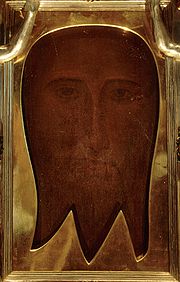
Genoa
Genoa |Ligurian]] Zena ; Latin and, archaically, English Genua) is a city and an important seaport in northern Italy, the capital of the Province of Genoa and of the region of Liguria....
, it was given in the 14th century to the Doge Leonardo Montaldo by the Byzantine Emperor John V Palaeologus.
The image was studied in detail in 1969 by Colette Dufour Bozzo, who dated the outer frame to the late 14th Century, while the inner frame and the image itself are believed to have originated earlier. Bozzo found that the image was imprinted on a cloth that had been pasted onto a wooden board. The similarity of the image with the Veil of Veronica suggests a link between the two traditions.
Holy Face of S. Silvestro
This image was kept in Rome’s church of S. SilvestroSan Silvestro
San Silvestro can refer to:*San Silvestro in Capite, church in Rome*San Silvestro al Quirinale, church in Rome...
until 1870 and is now kept in the Matilda chapel in the Vatican. It is housed in a Baroque frame donated by one Sister Dionora Chiarucci in 1623. The earliest evidence of its existence is 1517 when the nuns were forbidden to exhibit it to avoid competition with the Veronica. Like the Genoa image, it is painted on board and therefore is likely to be a copy.
It was exhibited at Germany’s Expo 2000 in the pavilion of the Holy See.
The Manoppello Image
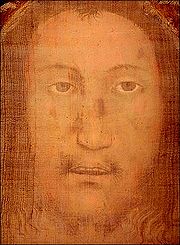
Rome
Rome is the capital of Italy and the country's largest and most populated city and comune, with over 2.7 million residents in . The city is located in the central-western portion of the Italian Peninsula, on the Tiber River within the Lazio region of Italy.Rome's history spans two and a half...
that he had found the Veil in a church of the Capuchin
Order of Friars Minor Capuchin
The Order of Friars Minor Capuchin is an Order of friars in the Catholic Church, among the chief offshoots of the Franciscans. The worldwide head of the Order, called the Minister General, is currently Father Mauro Jöhri.-Origins :...
monastery, in the small village of Manoppello, Italy, where it had been since 1660. Professor Pfeiffer had in fact been promoting this image for many years before.
According to local tradition, an anonymous pilgrim arrived in 1508 with the cloth inside a wrapped package. The pilgrim gave it to Dr. Giacomo Antonio Leonelli, who was sitting on a bench in front of the church. The doctor went into the church and opened the parcel containing the Veil. At once he went out of the church but he did not find the bearer of the packet. The Veil was owned by the Leonelli family until 1608. Pancrazio Petrucci, a soldier married to a female member of the family, Marzia Leonelli, stole the Veil from his father-in-law’s house. A few years later, Marzia sold it for 400 scudi to Doctor Donato Antonio De Fabritiis to pay a ransom demand for her husband who was then a prisoner in Chieti. The Veil was given by De Fabritiis to the Capuchins who still hold it today. This history was documented by Father Donato da Bomba in his “Relatione historica” following researches started in 1640.
Professor Pfeiffer claims that the image is the Veronica itself, which he suggests was stolen from the Vatican during rebuilding that took place in 1506, before the Sack of Rome. He further suggests it is the cloth placed over Jesus' face in the tomb and the image was a by-product of the forces unleashed by the resurrection, forces he also believes formed the image on the Shroud of Turin. Additionally he has suggested a history of the veil going back to the first Century. His narrative though is unsupported by evidence and is indistinguishable from fiction. There is no official evidence connecting the cloth with Rome. However, some have observed bits of glass embedded in the cloth, suggesting a connection between it and its former glass container in St. Peters, said to be smashed open when the cloth was stolen. Nevertheless, the cloth has received much publicity in recent years and Pope Benedict XVI
Pope Benedict XVI
Benedict XVI is the 265th and current Pope, by virtue of his office of Bishop of Rome, the Sovereign of the Vatican City State and the leader of the Catholic Church as well as the other 22 sui iuris Eastern Catholic Churches in full communion with the Holy See...
visited the veil on 1 September 2006.
The cloth is made of a rare fiber called byssus
Byssus
Byssus means both a silky filament by which certain molluscs attach themselves to hard surfaces, and a rare fabric, also called sea silk and its fibre source.-Word:...
, which is linen woven from a fine, yellowish flax referred to as sea silk
Sea silk
Sea silk is an extremely fine, rare and valuable fabric produced from the long silky filaments or byssus secreted by a gland in the foot of several bivalve molluscs by which they attach themselves to the sea bed....
, and used by ancient Egyptians and Hebrews. According to Paul Badde, the Vatican Correspondent for Die Welt
Die Welt
Die Welt is a German national daily newspaper published by the Axel Springer AG company.It was founded in Hamburg in 1946 by the British occupying forces, aiming to provide a "quality newspaper" modelled on The Times...
, this is a kind of fabric which is usually only found in the graves of Egyptian pharaohs.
Some feel that, despite claims of divine origins, the face on the veil at Manoppello conforms in appearance to the characteristics of a man-made image. Stylistically it is similar to images dating to the late Middle Ages or early renaissance; typical of representations of the human form from this period, it is imperfectly executed, with numerous stylised features, showing that the artist either did not understand, or did not wish to comply with the basic principles of proportion that apply to realistic renderings of the human form. However, some features, such as the crooked nose, might show the beaten, bruised and human Christ that people would expect to see in an actual divine image.
Indeed, it is far from certain that the face depicted has any connection with Jesus at all - one writer suggests that it is in fact a lost self portrait by artist Albrecht Dürer
Albrecht Dürer
Albrecht Dürer was a German painter, printmaker, engraver, mathematician, and theorist from Nuremberg. His prints established his reputation across Europe when he was still in his twenties, and he has been conventionally regarded as the greatest artist of the Northern Renaissance ever since...
(article).
A further objection, advanced by Ian Wilson
Ian Wilson (Christianity)
Ian Wilson is the prolific author of religious and scientific books. He often mixes the two while examining such topics as the Shroud of Turin or life after death.-Life:...
, is that because the image does not bear a familial resemblance to known copies (see above), it cannot be the version of the Veronica that was venerated in the Middle Ages. However, author Paul Badde in his 2010 book The Face of God, shows that Wilson's claim is incorrect. He shows illustrations of images made prior to 1608 of an openned eyed and open mouthed man just like the Manoppello image. After, 1608 most copies of the image changed to show closed eyes and a closed mouth. Badde contends that around this time is when the true image was stolen from the Vatican while it was to be moved to a new chapel which was under construction. Badde also points out that the original case with broken glass is on display at the Vatican museum and that it had glass on both sides. Only the image of Manoppello is visible from both sides of the cloth, thus the original case must have contained a cloth visible from both sides.
Representative art
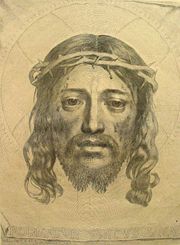
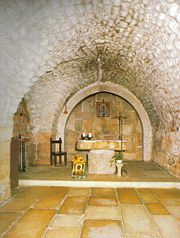
Type I:
- Veronica's Veil Domenico Fetti, circa 1620.
- Holy Face Giambono, fifteenth century. Civic Museum, Pavia, Italy.
- Holy Face Held by Two Angels Juan Sánchez Cotan, 1620-1625. Monastery of Cartuja, Granada.
- Holy Face Domenikos Theotokopoulos (El Greco). Convent of Capuchin Nuns, Toledo.
- Veronica's Veil Francisco de Zurbarán, seventeenth century. Parish Church of St Peter, Seville.
Type II:
- Sudarium of Saint Veronica Claude Mellan, 1649.
- Diptych of Saint Veronica with Christ and the Virgin Mary Bernardo Martorelli, fifteenth century. Museum of Mallorca.
- Holy Face, anonymous, early 17th century. Tretyakov Gallery, Moscow.
- Holy Face Simon Ushakov, 1678. Tretyakov Gallery, Moscow.
- Miracle of the Tear Juan Conchillos, 1680. Lady Chapel of the Monastery of the Holy Face, Alicante.
- Miracle of the Three faces Juan de Miranda, 1767. Alicante Ayuntamiento.
- Saint Veronica Antonio Castillo Lastrucci, 1946. Basilica of St Mary, Alicante.
See also
- AcheiropoietaAcheiropoietaAcheiropoieta — also called Icons Made Without Hands — are a particular kind of icon which are alleged to have come into existence miraculously, not created by a human painter. Invariably these are images of Jesus or the Virgin Mary...
- Black Madonna of CzęstochowaBlack Madonna of CzestochowaThe Black Madonna of Częstochowa is a revered icon of the Virgin Mary housed at the Jasna Góra Monastery in Częstochowa, Poland.-The icon:The origins of the icon and the date of its composition are still hotly contested among scholars...
- Image of EdessaImage of EdessaAccording to Christian legend, the Image of Edessa was a holy relic consisting of a square or rectangle of cloth upon which a miraculous image of the face of Jesus was imprinted — the first icon ....
- Relics attributed to JesusRelics attributed to JesusA number of relics associated with Jesus have been claimed and displayed throughout the history of Christianity. Some people believe in the authenticity of some relics; others doubt the authenticity of various items...
- Shroud of TurinShroud of TurinThe Shroud of Turin or Turin Shroud is a linen cloth bearing the image of a man who appears to have suffered physical trauma in a manner consistent with crucifixion. It is kept in the royal chapel of the Cathedral of Saint John the Baptist in Turin, northern Italy. The image on the shroud is...
- Sudarium of OviedoSudarium of OviedoThe Sudarium of Oviedo, or Shroud of Oviedo, is a bloodstained cloth, measuring c. 84 x 53 cm, kept in the Cámara Santa of the Cathedral of San Salvador, Oviedo, Spain. The Sudarium is claimed to be the cloth wrapped around the head of Jesus Christ after he died, as mentioned in the Gospel of...
Further reading
- Joan Carroll Cruz, OCDS, Miraculous Images of Our Lord. ISBN 0-89555-496-8
- EEwa Kuryluk, Veronica and Her Cloth: History, Symbolism, and Structure of a True Image. ISBN 0631178139

